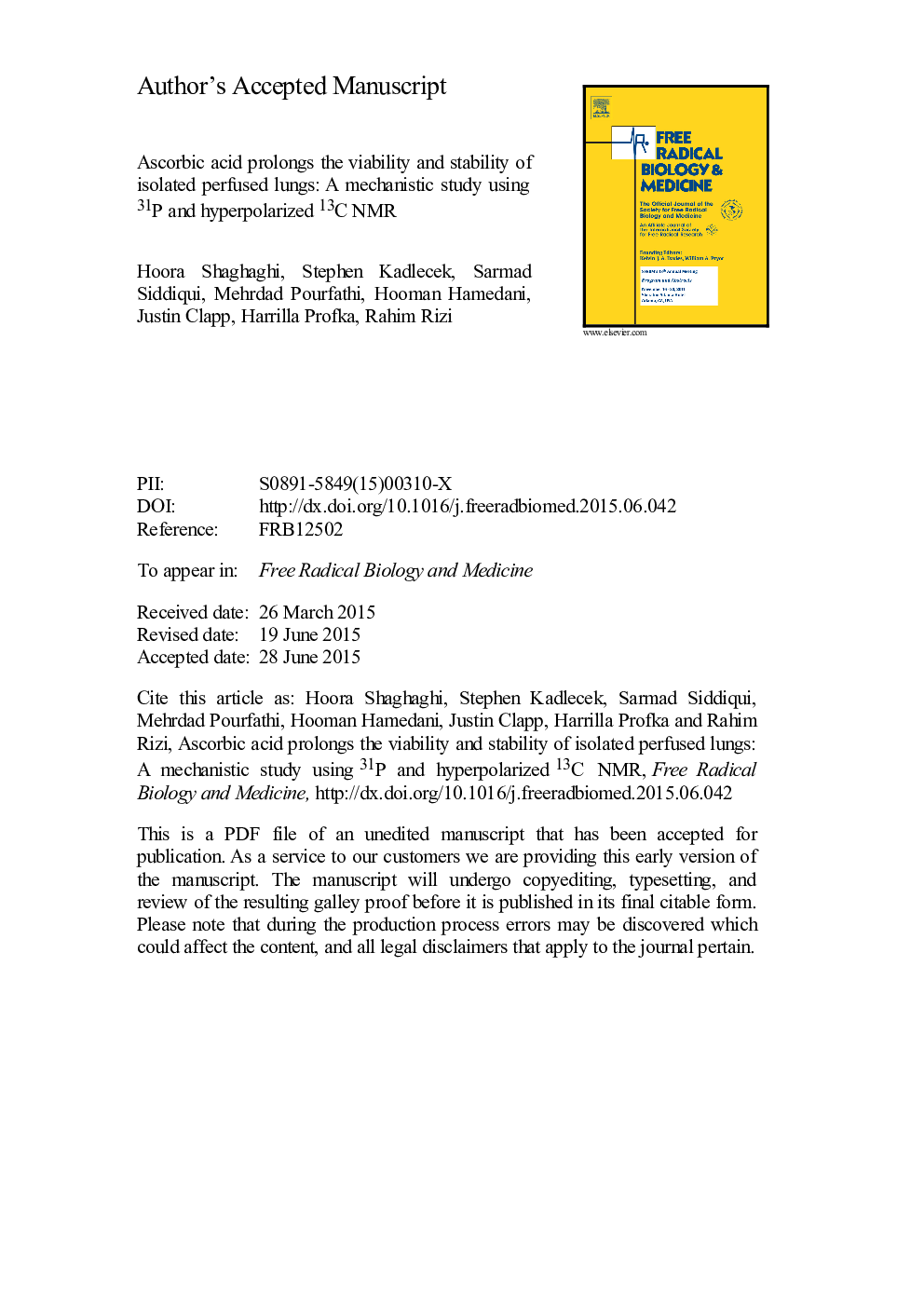| کد مقاله | کد نشریه | سال انتشار | مقاله انگلیسی | نسخه تمام متن |
|---|---|---|---|---|
| 8268387 | 1534954 | 2015 | 43 صفحه PDF | دانلود رایگان |
عنوان انگلیسی مقاله ISI
Ascorbic acid prolongs the viability and stability of isolated perfused lungs: A mechanistic study using 31P and hyperpolarized 13C nuclear magnetic resonance
دانلود مقاله + سفارش ترجمه
دانلود مقاله ISI انگلیسی
رایگان برای ایرانیان
کلمات کلیدی
GPETMPDPDHcEVLPHyperpolarizeddehydroascorbateADPGPCALA31P NMRPAMGSHASAnuclear magnetic resonance - رزونانس مغناطیسی هستهایBSA - BSAIRI - IRROS - ROSAdenosine Triphosphate - آدنوزین تری فسفاتATP - آدنوزین تری فسفات یا ATPadenosine diphosphate - آدنوزین دی فسفاتAscorbic acid - آسکوربیک اسیدIschemia–reperfusion injury - آسیب مجدد ایسکمی-رپرفیوژنbovine serum albumin - آلبومین سرم گاوα-Lipoic acid - اسید α-لیپوئیکischemia–reperfusion - ایسکمی-رپرفیوژنNMR - تشدید مغناطیسی هستهای DHA - دوکوساهگزائنوئیک اسید13C NMR - رزونانس مغناطیسی هسته ای کربن 13electron transport chain - زنجیره انتقال الکترونEnergy charge - شارژ انرژیPME - شرکتهای کوچک و متوسطinorganic phosphate - فسفات معدنیPhosphocreatine - فسفریکراتینOxidative phosphorylation - فسفوریلاسیون اکسیداتیوPhosphomonoester - فسفومونوئسترMetabolism - متابولیسم ETc - و غیرهPCR - واکنش زنجیرهٔ پلیمرازEx vivo lung perfusion - پرفیوژن ریوی ex vivopyruvate dehydrogenase complex - پیرووات دهیدروژناز پیچیدهGlutathione - گلوتاتیونReactive oxygen species - گونههای فعال اکسیژن
موضوعات مرتبط
علوم زیستی و بیوفناوری
بیوشیمی، ژنتیک و زیست شناسی مولکولی
سالمندی
پیش نمایش صفحه اول مقاله

چکیده انگلیسی
Ex vivo lung perfusion (EVLP) has recently shown promise as a means of more accurately gauging the health of lung grafts and improving graft performance post-transplant. However, reperfusion of ischemic lung promotes the depletion of high-energy compounds and a progressive loss of normal mitochondrial function, and it remains unclear how and to what extent the EVLP approach contributes to this metabolic decline. Although ascorbate has been used to mitigate the effects of ischemia-reperfusion injury, the nature of its effects during EVLP are also not clear. To address these uncertainties, this study monitored the energy status of lungs during EVLP and after the administration of ascorbate using 31P and hyperpolarized 13C NMR (nuclear magnetic resonance). Our experiments demonstrated that the oxidative phosphorylation capacity and pyruvate dehydrogenase flux of lungs decline during ex vivo perfusion. The addition of ascorbate to the perfusate prolonged lung viability by 80% and increased the hyperpolarized 13C bicarbonate signal by a factor of 2.7. The effect of ascorbate is apparently due not to its antioxidant quality but rather to its ability to energize cellular respiration given that it increased the lung's energy charge significantly, whereas other antioxidants (glutathione and α-lipoic acid) did not alter energy metabolism. During ascorbate administration, inhibition of mitochondrial complex I with rotenone depressed energy charge and shifted the metabolic state of the lung toward glycolysis; reenergizing the electron transport chain with TMPD (N,N,N',N'-tetramethyl-p-phenylenediamine) recovered metabolic activity. This indicates that ascorbate slows the decline of the ex vivo perfused lung's mitochondrial activity through an independent interaction with the electron transport chain complexes.
ناشر
Database: Elsevier - ScienceDirect (ساینس دایرکت)
Journal: Free Radical Biology and Medicine - Volume 89, December 2015, Pages 62-71
Journal: Free Radical Biology and Medicine - Volume 89, December 2015, Pages 62-71
نویسندگان
Hoora Shaghaghi, Stephen Kadlecek, Sarmad Siddiqui, Mehrdad Pourfathi, Hooman Hamedani, Justin Clapp, Harrilla Profka, Rahim Rizi,